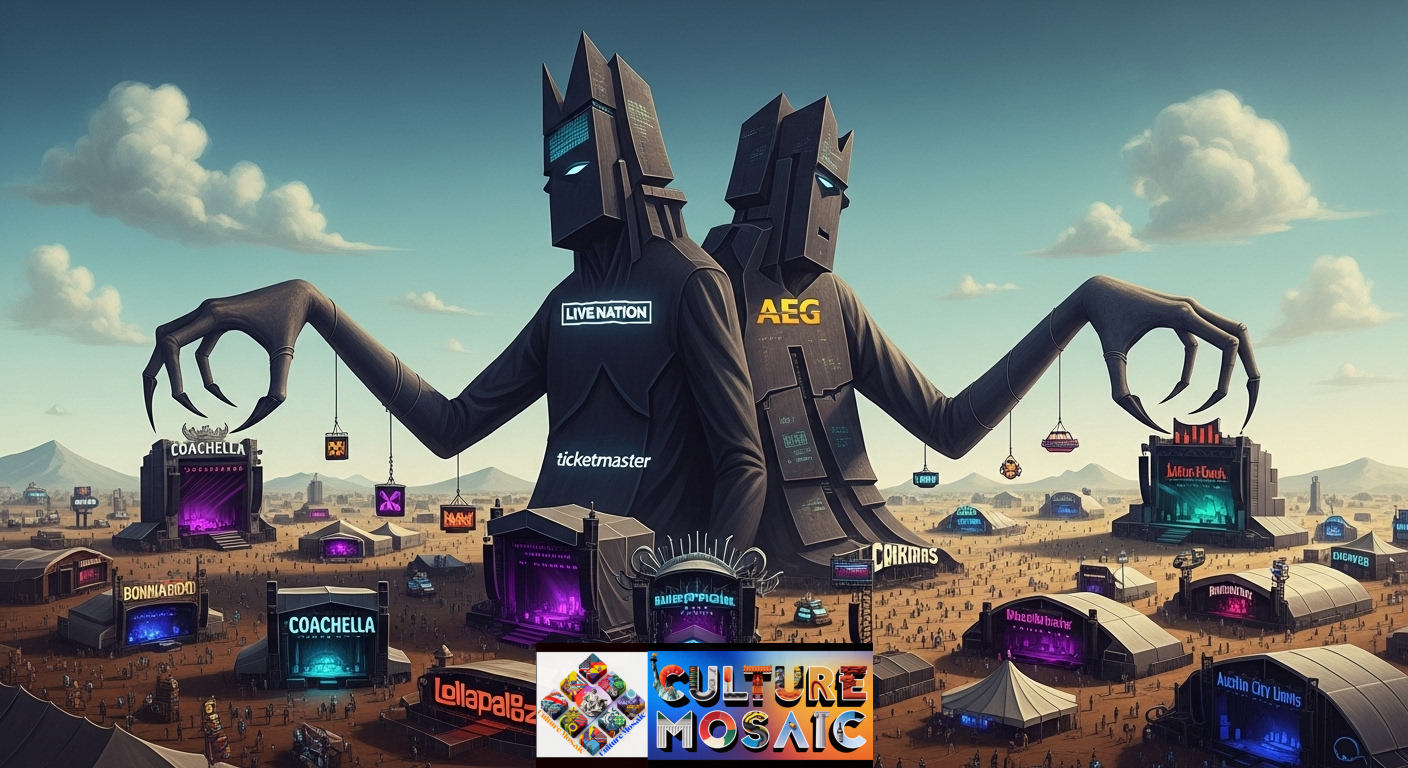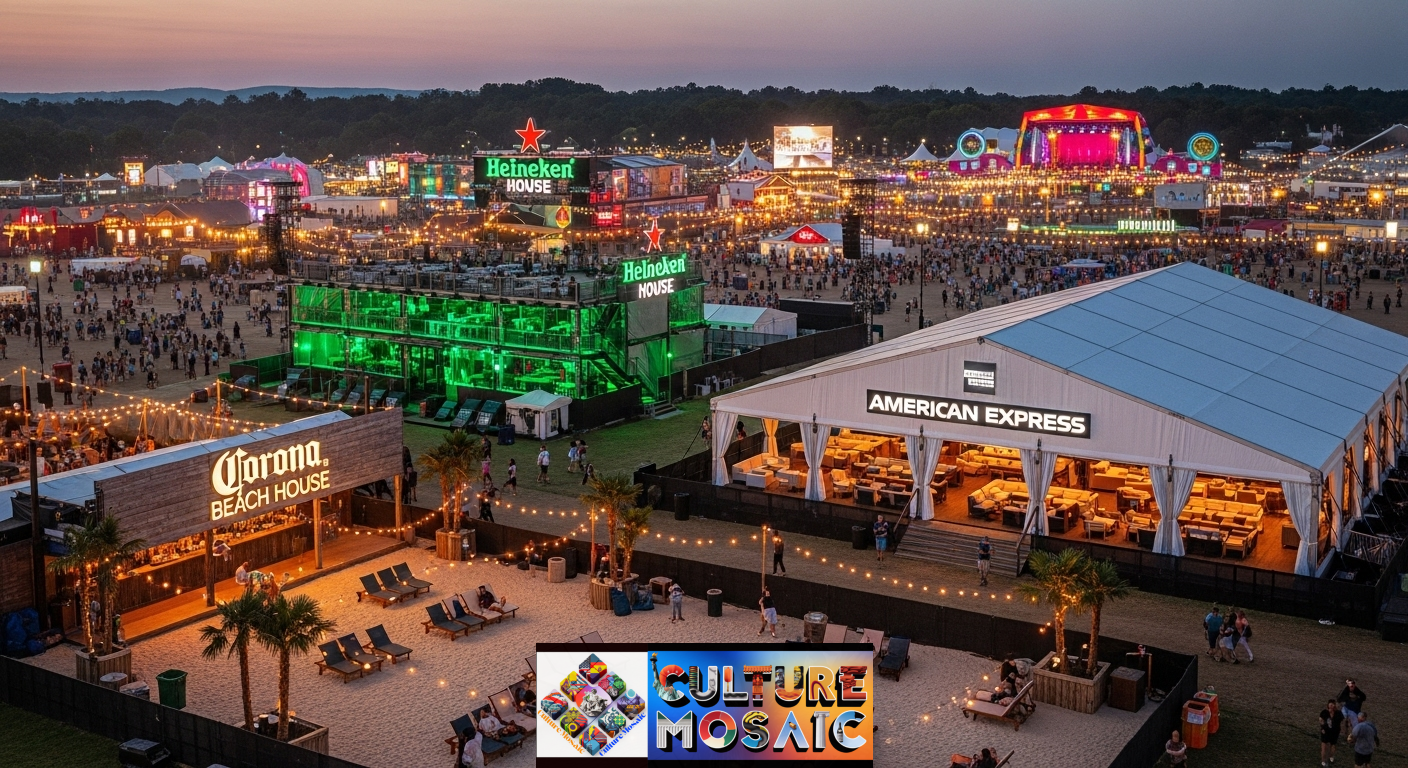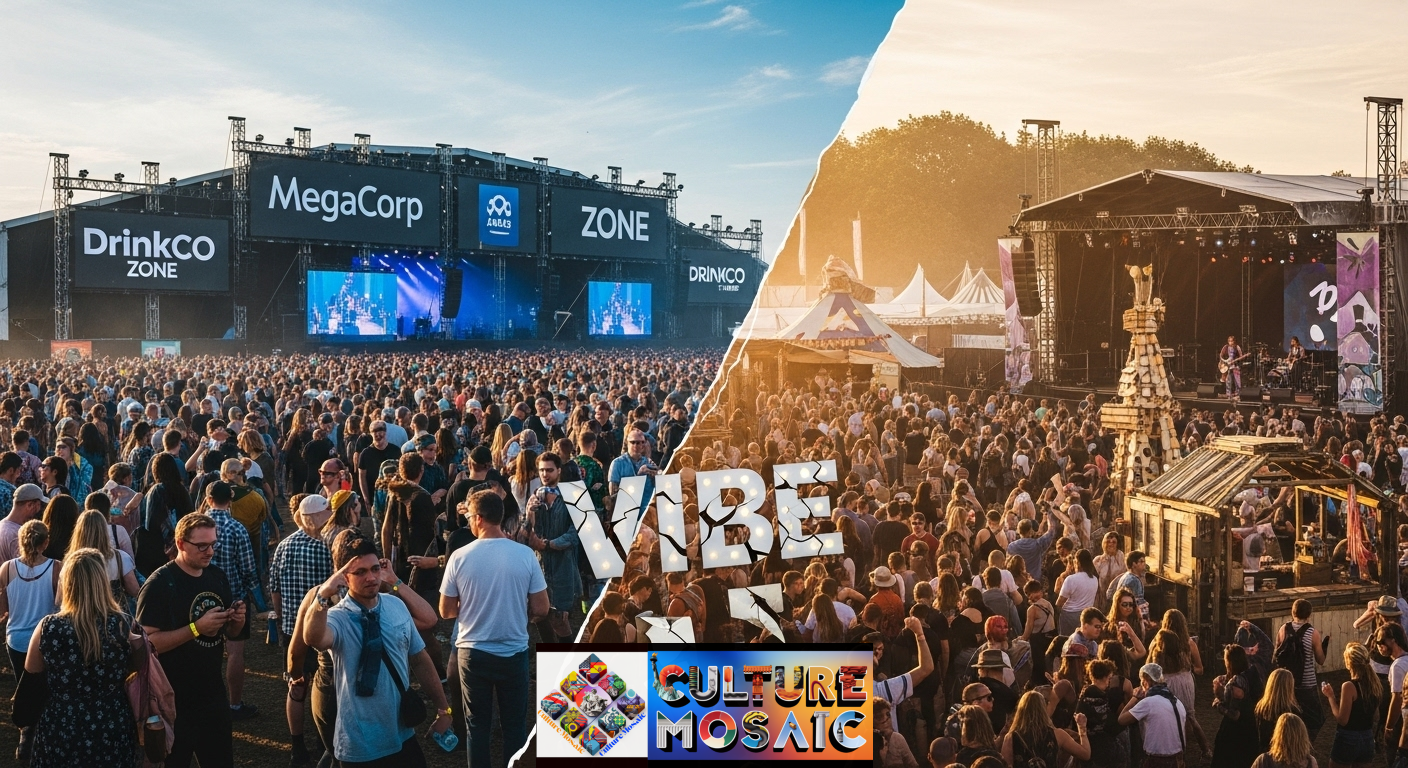US Festival Fever Corporate Vibe Killer: Remember when music festivals felt like discovering a secret? When the vibe was sweaty crowds singing together under dusty skies, and the biggest sponsor was maybe a local beer company with a modest tent? That version of US festival fever feels increasingly like a relic.
The American festival landscape has undergone a dramatic transformation. What started as countercultural gatherings and independent music celebrations has morphed into a highly corporatized industry dominated by massive entertainment conglomerates. The result is what many longtime festival-goers describe as a complete vibe killer, where authentic experiences have been replaced by calculated brand activations and profit-maximizing strategies.
This isn’t just nostalgic complaining. The data backs up the frustration. Festival wellness ticket prices have skyrocketed while lineups have become increasingly homogenized. The spontaneous magic that defined festival culture is being systematically engineered out in favor of shareholder returns.
The Live Nation and AEG Monopoly Problem

Two companies essentially control the American festival landscape: Live Nation Entertainment and AEG Presents. Together, they produce or promote the vast majority of major US music festivals, from Coachella and Lollapalooza to Bonnaroo and Austin City Limits.
Live Nation, which merged with Ticketmaster in 2010, operates as a vertically integrated behemoth. They own the venues, control the ticketing, book the artists, and even manage the merchandise sales. This consolidation creates what economists call a natural monopoly, where competition becomes nearly impossible.
AEG, while slightly smaller, follows the same playbook. Their Coachella franchise alone generates hundreds of millions annually and sets trends that ripple across the entire industry.
The music festival consolidation critique centers on a simple reality: when two companies control almost everything, they optimize for profit rather than experience. Artists face pressure to accept lower fees because these promoters control access to the biggest stages. Festival-goers pay premium prices because there are limited alternative options. Independent promoters struggle to compete against companies with unlimited capital and exclusive venue contracts.
The corporate sponsorship festival experiential economy has fundamentally changed as a result. Every element becomes an opportunity for monetization, from naming rights to “experiential marketing zones” that feel more like shopping malls than music venues.
How Corporate Sponsorships Changed the Festival Ground Experience

US Festival Fever Corporate Vibe Killer: Walk through any major US festival today, and you’ll navigate a maze of brand activations before reaching a single stage. The Corona Beach House. The Heineken House. The American Express Lounge. Each one is larger and more extravagant than the previous one.
Corporate sponsors have always existed in the festival ecosystem, but their role has expanded dramatically. What used to be simple banner ads has evolved into immersive branded experiences that dominate valuable real estate and compete for attendee attention.
The problem isn’t sponsorship itself. Independent festivals need revenue streams to survive. The issue is scale and integration. When corporate partnerships become the primary design consideration, the immersive festival aesthetic shifts. Stages get positioned to funnel crowds past sponsor zones. Programming schedules align with brand activation hours. Even the visual aesthetic gets sanitized to meet corporate approval standards.
For attendees, this creates a dissonant experience. You came for music and community, but you’re constantly reminded that you’re also a consumer in a carefully constructed retail environment. That cognitive dissonance is what people mean when they call it a US festival fever corporate vibe killer.
The VIP experience has become particularly emblematic of this shift. Premium ticket tiers now include air-conditioned lounges, gourmet catering, and private viewing areas that physically separate the wealthy from general admission crowds. The egalitarian spirit that defined early festival culture, where everyone danced together regardless of economic status, has been replaced by literal class segregation.
Rising Ticket Prices and Shrinking Artist Diversity

US Festival Fever Corporate Vibe Killer: The economics tell a brutal story. In 2010, a three-day general admission pass to Coachella cost around $300. Today, the same ticket approaches $600, and that’s before mandatory fees, parking, and camping costs. Lollapalooza, Bonnaroo, and most other major festivals follow similar pricing trajectories.
Wages haven’t doubled in that timeframe. Festival attendance hasn’t become twice as comfortable or convenient. The music hasn’t gotten objectively better. What changed is the corporate ownership structure and profit expectations.
When private equity and public shareholders enter the equation, festivals are required to generate increasing returns year over year. That pressure translates directly into higher ticket prices, more sponsor integrations, and cost-cutting measures that degrade the attendee experience.
Artist lineups have suffered alongside ticket prices. The Live Nation and AEG monopoly means festivals increasingly book from the same pool of available artists. Rush tour routing gets coordinated across events to maximize efficiency for the promotion companies rather than create unique experiences for festival-goers.
Browse the lineups for major US festivals in any given year and you’ll notice remarkable overlap. The same headliners rotate through the circuit with minor variations. Mid-tier artists appear at six or seven different events. The curatorial vision that once distinguished festivals from each other has been smoothed into interchangeable products.
This homogenization extends beyond just artist selection. Stage design, food vendor options, and even the festival fashion aesthetic have become standardized. When everything feels familiar, nothing feels special.
Is Festival Culture Dead in the US?

US Festival Fever Corporate Vibe Killer: The question “Is festival culture dead US?” gets asked frequently in music forums and social media discussions. The answer is complicated.
Mainstream festival culture, as it existed from roughly 1995 to 2015, has certainly transformed beyond recognition. The spontaneous, countercultural energy that defined events like early Burning Man or the original Lollapalooza has been systematically corporatized. If you’re looking for that specific vibe at major commercial festivals, you’ll likely be disappointed.
But festival culture itself hasn’t died. It’s splintered and evolved. Many passionate music fans have simply opted out of the corporate festival circuit entirely, seeking alternatives that better align with their values and expectations.
The energy has migrated to smaller, independent events that prioritize community and artistic integrity over profit maximization. These festivals may lack the Instagram-worthy production design and celebrity headliners, but they offer something increasingly rare: authentic cultural experiences that haven’t been focus-grouped into bland palatability.
Regional festivals with local artist rosters, genre-specific gatherings that celebrate musical subcultures, and environmental initiatives that emphasize sustainable festival experience over scale are all thriving. They just don’t generate the same media coverage as corporate mega-events.
The corporate vibe killer phenomenon has actually created an opportunity. As major festivals become less appealing to core music enthusiasts, independent promoters have found audiences hungry for alternatives. The festival ecosystem is diversifying rather than dying, with a clear separation between commercial entertainment products and cultural experiences.
The Rise of Independent Music Festivals US
US Festival Fever Corporate Vibe Killer: Independent music festivals US represent the antidote to corporate consolidation. These events operate outside the Live Nation and AEG ecosystem, often organized by passionate individuals or small collectives with deep roots in specific music communities.
Examples include Desert Daze in California, which emphasizes psychedelic and experimental music with artist-curated lineups. Levitation in Austin builds around the city’s legendary underground music scene. Pickathon in Oregon pioneered eco-friendly festival practices and focuses exclusively on emerging artists rather than established headliners.
These independent festivals typically operate at smaller scales, with attendance capped between 5,000 and 20,000 people rather than the 100,000-plus crowds at corporate events. The intimacy is intentional. It allows for better sound quality, more artist-fan interaction, and stronger community bonds among attendees.
Financial models differ significantly as well. Independent promoters rely more heavily on ticket sales and less on corporate sponsorships. When sponsors do participate, they tend to be locally-owned businesses or companies with genuine connections to the music community rather than multinational beverage conglomerates.
The booking philosophy prioritizes discovery over familiarity. Independent festivals introduce audiences to artists they’ve never heard rather than recycling the same headliners everyone has seen multiple times. Curatorial vision actually matters because the organizers are music fans first and business operators second.
Sustainability practices tend to be stronger at independent events. Without pressure to maximize short-term profits, organizers can invest in composting infrastructure, renewable energy, and waste reduction programs that would get cut from corporate festival budgets as unnecessary expenses.
The challenge facing independent music festivals is scalability and stability. Without corporate backing, they’re vulnerable to financial shocks like weather cancellations or last-minute artist dropouts. Many operate on razor-thin margins where a single bad year could force closure.
What Killed the Authentic Festival Vibe
The US festival fever corporate vibe killer isn’t one single factor but rather a combination of interconnected business decisions that collectively transformed the industry.
Vertical integration destroyed checks and balances in the ecosystem. When the same company controls ticketing, venues, promotion, and artist management, there’s no competitive pressure to improve any individual component. Ticketmaster fees can increase indefinitely because there’s no alternative platform. Artist guarantees can decrease because there are limited options for touring outside the Live Nation network.
Data-driven decision-making replaced curatorial instincts. Corporate festivals rely heavily on streaming numbers and social media metrics to determine bookings. This creates a feedback loop where already-popular artists get booked repeatedly while emerging talent struggles to break through. The result is safer, more predictable lineups that minimize financial risk but also eliminate the possibility of magical discovery.
Financialization changed fundamental incentives. When festivals operated as independent businesses, success meant creating memorable experiences that generated word-of-mouth buzz and loyal returning customers. When festivals became assets in corporate portfolios, success meant hitting quarterly earnings targets and maximizing extractable value.
The Instagram-ification of festival culture shifted focus from music to aesthetics. As social media became central to how people experience and share events, festivals optimized for visual spectacle over sonic quality. Elaborate art installations and photogenic moments became more important than stage production or artist development. Attendees increasingly came for content creation opportunities rather than musical immersion.
Demographic targeting replaced organic community building. Corporate festivals use sophisticated marketing analytics to identify and target the most profitable customer segments. This creates festivals that feel demographically homogeneous, lacking the cross-cultural mixing that defined earlier eras when festivals attracted genuinely diverse crowds united by musical passion rather than consumer profiles.
Finding Better Festival Experiences
US Festival Fever Corporate Vibe Killer: If you’re frustrated by the corporate festival landscape, practical alternatives exist. The key is knowing where to look and adjusting expectations about scale and production values.
Start by researching regional festivals in your area or places you’d like to visit. Most cities have smaller music events that fly under the national radar but offer excellent lineups and community vibes. These festivals often happen in city parks or small venues rather than sprawling festival grounds, but the intimacy enhances rather than detracts from the experience.
Genre-specific festivals provide deep immersion in particular musical communities. If you love bluegrass, electronic music, metal, or jazz, dedicated festivals exist that celebrate those sounds with knowledgeable audiences and carefully curated programs. You’ll be surrounded by people who genuinely care about the music rather than casual festival-goers checking off a lifestyle activity.
Look for festivals with clear values beyond entertainment. Events that emphasize environmental sustainability, local economic development, or social causes tend to attract more intentional communities. The shared values create natural connection points beyond just being in the same physical space.
Consider international options if the budget permits. European and Asian festival cultures haven’t consolidated to the same degree as the US market. Events like Primavera Sound in Spain or Fuji Rock in Japan offer world-class lineups without the oppressive corporate branding that defines American mega-festivals.
Volunteer opportunities provide festival access at reduced cost while connecting you more deeply with the organizational community. Most festivals rely heavily on volunteer labor, and working a few shifts often grants you free admission plus a behind-the-scenes perspective that enhances your overall experience.
Lower your production expectations and raise your musical standards. Accept that independent festivals may have less elaborate stage designs and fewer Instagram-worthy installations. Focus instead on sound quality, artist accessibility, and the energy of crowds that came specifically for the music rather than social media content.
US Festival Fever Corporate Vibe Killer: The Future of US Festival Culture
US Festival Fever Corporate Vibe Killer: The trajectory of American festival culture will likely continue diverging into two distinct paths. Corporate mega-festivals will grow larger and more commercialized, essentially becoming outdoor entertainment complexes that happen to include live music. Independent festivals will remain smaller and more specialized, serving passionate musical subcultures rather than mass audiences.
Technology will play an increasingly significant role. Virtual reality components, cashless payment systems, and augmented reality experiences will become standard at corporate events, further emphasizing technological spectacle over human connection. Independent festivals may resist or selectively adopt technologies that enhance rather than replace analog experiences.
Economic pressures could force consolidation even among independent promoters. Rising costs for insurance, permits, security, and artist fees make it harder to operate without corporate backing. Some independent festivals may accept acquisition offers while others struggle to remain viable.
Climate change will fundamentally reshape festival logistics and timing. Extreme weather events are already causing cancellations and relocations. Festivals may shift to different seasons or regions to avoid increasingly unpredictable conditions. Those who invest early in climate adaptation and sustainability will have competitive advantages.
Generational preferences will continue evolving. Younger audiences who grew up with streaming and social media may have different expectations about what festivals should provide. The communal experience that older generations valued may matter less than individual content creation opportunities and personalized experiences.
The US festival fever corporate vibe killer phenomenon ultimately reflects broader economic trends toward consolidation and financialization across industries. Festivals are just one more cultural space being transformed by the logic of maximizing shareholder returns.
US Festival Fever Corporate Vibe Killer: But human desire for authentic musical community remains constant. As long as people want to gather around shared artistic experiences, alternatives to corporate festivals will emerge and evolve. The magic isn’t dead. It’s just migrated to different spaces and taken on new forms.
FAQs About US Festival Fever Corporate Vibe Killer
Why are US music festival tickets so expensive now?
Ticket prices have increased dramatically due to corporate consolidation in the festival industry. When companies like Live Nation and AEG control most major festivals, they can raise prices without facing competitive pressure. Additionally, these corporations must generate increasing profits for shareholders, which translates directly into higher ticket costs. Fees, VIP packages, and premium experiences add additional layers of pricing that didn’t exist when festivals were independently operated.
What’s the difference between corporate and independent music festivals?
Corporate festivals are owned and operated by large entertainment conglomerates like Live Nation or AEG, typically featuring big-name headliners, extensive brand sponsorships, and crowds of 50,000 or more. Independent music festivals are run by smaller organizations or individuals, usually emphasizing curatorial vision, emerging artists, and community building over profit maximization. Independent events tend to be smaller (5,000 to 20,000 attendees), more affordable, and less commercialized.
Are Live Nation and AEG really monopolies?
While not technically monopolies in legal terms, Live Nation and AEG function as a duopoly that controls the vast majority of the US festival market. Live Nation’s merger with Ticketmaster created a vertically integrated company that dominates ticketing, promotion, and venue ownership. This consolidation limits competition and gives these companies enormous pricing power over both artists and consumers. The market concentration concerns regulators and industry observers. US Festival Fever Corporate Vibe Killer
How can I find authentic festival experiences instead of corporate events?
Research regional and genre-specific festivals in areas you’d like to visit. Look for events with attendance under 20,000 that emphasize local artists or specific musical communities. Check festival websites for sustainability commitments and sponsor lists; fewer corporate brands usually indicate more independent operations. Music blogs, Reddit communities, and local music venues often highlight smaller festivals that don’t have big marketing budgets but offer superior cultural experiences.
Is festival culture actually dying or just changing?
Festival culture is transforming rather than dying. Mainstream corporate festivals have become commercialized entertainment products that feel disconnected from the countercultural roots of festival tradition. However, passionate music communities are creating alternative festival experiences that prioritize artistic integrity and authentic community over profit. The energy has shifted from mega-events to smaller, independent gatherings, but the fundamental human desire to gather around shared musical experiences remains strong.

